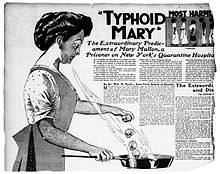インデックス・ケース
インデックス・ケース(英語: index case)は、疫学調査上で集団内最初の患者となった人物を指す言葉である[1][2]。プライマリー・ケース(primary case)、ペイシェント・ゼロ(patient zero)も同様の意味である。日本語では「初発症例」「発端症例」[3][注釈 1]などの訳語が当てられることがある。
インデックス・ケースという語は、この他、遺伝学では原因と目される遺伝要因を家族内で調査するきっかけを作った最初の発症者(発端者、英: propositus / proband)を指したり[4]、前頭葉に大きな損傷を負いながら生還したフィニアス・ゲージの一例など、文献上「古典的な」位置づけを得ることもある。
- 「ペイシェント・ゼロ」という語は、北アメリカでのヒト免疫不全ウイルス (HIV)感染のインデックス・ケースと考えられた人物(後出)に対して使われた[6][7]。日本語では「ゼロ号患者」(0号患者)[8]と訳される。ここから転じて、医療以外の分野でも、コンピュータネットワーク上で初めてマルウェアに感染した人など、他人へ蔓延する何か良くないものに初めて感染した個体をペイシェント・ゼロと呼ぶことがある[9]。現在「ペイシェント・ゼロ」の単語は、感染症アウトブレイクが起こった際の初患者や、コンピューター・ウイルスの初感染例を指す言葉としてメディアで使われるほか、より広い意味では、広範な影響を及ぼす企画や行動の源泉を指す言葉としても用いられる[要検証][10][11][12][13][14]。
意義
[編集]インデックス・ケースからは、病気の出所や考えられる伝染状況、アウトブレイク中に病気に感染していたリザーバーが誰かなど、さまざまな情報を得られる可能性がある。また、アウトブレイクのきっかけとなった最初期の感染例でもあり、第1・第2・第3(英: primary, secondary, tertiary, etc.)とナンバリングされることもある[15]。
ロンドン大学衛生熱帯医学大学院の感染症疫学者であるデイヴィッド・ヘイマンは、インデックス・ケース(ペイシェント・ゼロ)を見つける意義について問われ、「ペイシェント・ゼロを見つけることが重要な例もあるが、それは患者がまだ生きていて病気を蔓延させている時に限る。大概の場合、特に病気の大きなアウトブレイクの場合、そういうことは必要無い」と述べている[16]。
「ペイシェント・ゼロ」ガエタン・デュガ
[編集]
AIDS流行の最初期、アメリカ疾病予防管理センター (CDC) のウィリアム・ダロウらのチームは、「ペイシェント・ゼロ」 から伝染が起きたというシナリオを考えていた[18]。CDCは、カナダ人のガエタン・デュガがヨーロッパからアメリカへウイルスを持ち込んだキャリアで、別の男性へ感染を広げたと特定した[19]。発表された疫学研究は、「ペイシェント・ゼロ」がどのようにヒト免疫不全ウイルス (HIV)を複数のパートナーへ感染させたか、そして彼らがさらに別人に感染させ、このウイルスがどれだけのスピードで全世界に広がったかを示すものだった (Auerbach et al., 1984)。
ジャーナリストのランディ・シルツはダロウらの発見に基づいて[18]、1987年の著書『そしてエイズは蔓延した』で、デュガこそがペイシェント・ゼロだとした。この本はピューリッツァー賞を受賞し、後に『運命の瞬間/そしてエイズは蔓延した』として映画化された。[20][21]。シルツの著書に拠れば、客室乗務員だったデュガは北アメリカの複数の都市の有料発展場で乱交を行っていたという。デュガはゲイ男性間のHIV感染を広めた人物として広く知られ、「マス・スプレッダー」(英: "mass spreader")として中傷された。4年後、ダロウは研究のメソッドと、シルツが結論に至った過程を批判するに至った[18]。
2007年に投稿された論文では、遺伝子解析に基づき、現在北アメリカで流行しているHIVの系列は、アフリカからハイチを辿って1969年頃にアメリカへ入ったものと推定され[22][23]、そのソースは1人の移民だったと結論付けられている。しかしながら、ミズーリ州セントルイスでAIDS合併症により1969年に死亡したロバート・レイフォードは、1966年以前にHIV感染したと考えられており、北アメリカのHIV系列最初期のキャリアとされている[24][25]。これにより、デュガが北アメリカにHIVをもたらしたのではなく、多くの患者の1人にすぎなかったことがあらためて立証された[26]。
著名なインデックス・ケース
[編集]
- 1854年にロンドン、ブロード・ストリートで起きたコレラ流行では、ブロード・ストリート40番地のルイス・ハウス(英: the Lewis House at 40 Broad Street)の乳児がインデックス・ケースと考えられている(スティーヴン・ジョンソン、『感染地図―歴史を変えた未知の病原体』、2005年)[27]。
- 「チフスのメアリー」(英: "Typhoid Mary")として知られるメアリー・マローンは、ニューヨークで起きた1900年代初頭の腸チフスアウトブレイクのインデックス・ケースである。無症候性キャリアだった彼女は、料理人として働く間に50人近くへ感染を広げた。インデックス・ケースとして特定後、死亡までニューヨーク・ノース・ブラザー島にある病院へ強制隔離された[28][29]。

- 2003年2月、広東省の医者だった64歳の男性は重症急性呼吸器症候群 (SARS)の治療に携わった後、香港へ行き、メトロポール・ホテル9階に宿泊してアウトブレイクを引き起こした[30][31]。同じ階に宿泊した客が多く感染し、この病気が世界中に広まるきっかけを作ったことが指摘されている[32]。
- 2009年に起きた新型インフルエンザの世界的流行では、エドゥガル・エンリケ・エルナンデス(スペイン語: Édgar Enrique Hernández)がペイシェント・ゼロと考えられており[33]、後に回復したことから、彼を讃える像が建立された[34]。同時期にウイルスに接触したマリア・アデラ・グティエレス(スペイン語: Maria Adela Gutierrez)が、公式に確認された最初の死者である。
- 2014年の西アフリカエボラ出血熱流行では、1人の2歳児がインデックス・ケースになったと考えられている[35]。
医療以外の分野での用例
[編集]「ペイシェント・ゼロ」の語は、ネットワークであるマルウェアに初めて感染し、その後他のシステムへ感染を広げたコンピュータ・ユーザを指して使われることがある[9][36]。
モニカ・ルインスキーは、インターネット上で大勢からの嫌がらせを受けた最初の人物だとして、自身を「ペイシェント・ゼロ」と表現した[37]。
フィクション
[編集]1993年の映画『ゼロ・ペイシェンス』は、AIDSの「ペイシェント・ゼロ」の汚名を着せられた人物が死者の国から戻ってくるというミュージカル映画。
映画『アウトブレイク』では、インデックス・ケース探しが物語の大筋となっている。映画『コンテイジョン』では、グウィネス・パルトロー演じるエリザベス・エンホフが、登場する致死性ウイルスMEV-1のインデックス・ケースとなる。
スマートフォン・ゲーム『Plague inc.』では、プレイヤーの作ったウイルスについて情報を集めるため、CDCにペイシェント・ゼロを探させることができる。ゲーム『Prototype』では、主人公のアレックス・マーサーが、研究所で開発されたウイルスのペイシェント・ゼロとなってしまう。
脚注
[編集]注釈
[編集]- ^ 「初発」の語は、癌や食物アレルギーなどの症例で「(ある人が)ある病気を初めて発症した」という意味(「再発」の対語)で使われることもあるので区別すること。
出典
[編集]- ^ “Diseases – Activity 1 – Glossary, page 3 of 5”. science.education.nih.gov. 2010年11月3日閲覧。
- ^ “WordNet Search – 3.0”. Princeton University, wordnetweb.princeton.edu. 3 November 2010閲覧。
- ^ 小西友七; 南出康世 (25 April 2001). "index case". ジーニアス英和大辞典. ジーニアス. 東京都文京区: 大修館書店 (published 2011). ISBN 978-4469041316. OCLC 47909428. NCID BA51576491. ASIN 4469041319. 全国書誌番号:20398458。
{{cite encyclopedia}}:|access-date=を指定する場合、|url=も指定してください。 (説明) - ^ “Definition of index case”. The free medical dictionary by farlex. 2017年9月27日閲覧。
- ^ Giesecke, Johan. “Primary and index cases”. The Lancet 384 (9959). doi:10.1016/s0140-6736(14)62331-x.
- ^ Davis, Nicola (27 October 2016). “Gaétan Dugas: 'patient zero' not source of HIV/Aids outbreak, study confirms”. The Guardian. 2017年9月27日閲覧。
- ^ “Patient Zero – definition of Patient Zero in the Medical dictionary – by the Free Online Medical Dictionary, Thesaurus and Encyclopedia”. medical-dictionary.thefreedictionary.com. 3 November 2010閲覧。
- ^ “飛沫感染/接触感染、平成29年度全国労働衛生週間講話”. 2019年12月25日閲覧。
- ^ a b “Search for patient zero: uncovering malware infection at the source”. Infosecurity Magazine. (10 July 2012) 31 March 2017閲覧. ""Medical researchers look for patient zero to find out where a virus outbreak started and what places and people patient zero came into contact with in order to contain the outbreak and prevent further infections. Similarly, infosec researchers need to look for the user who first introduced the malware into the network, which application was carrying the malware, and the files that are causing it to spread in order to contain it, eliminate it, and prevent reinfection, explained Huger, vice president of development at Sourcefire's cloud technology group.""
- ^ “Have Doctors Found Swine "Patient Zero?"”. CBS News. (2009年4月29日)
- ^ “Researchers trawl for Conficker's 'Patient Zero' – Techworld.com”. news.techworld.com. 2010年11月3日閲覧。
- ^ “Patient Zero”. TV.com (2006年3月20日). 2010年11月3日閲覧。
- ^ Lemos, Robert. “Witty worm traced to 'Patient Zero'”. The Register. 2017年9月27日閲覧。
- ^ “That Man in the White House”. The Weekly Standard (28 November 2003). 3 November 2010閲覧。
- ^ “Sporadic STEC O157 Infection: Secondary Household Transmission in Wales”. Centers for Disease Control and Prevention, USA, www.cdc.gov (1 January 1994). 3 November 2010閲覧。
- ^ Mohammadi, Dara (2015-01-15). “Finding patient zero”. The Pharmaceutical Journal 294 (7845) 2015年1月16日閲覧. "But according to David Heymann, an infectious-disease epidemiologist at the London School of Hygiene & Tropical Medicine, it’s not quite like that. “Finding patient zero may be important in some instances,” he says, “but only if they are still alive and spreading the disease. And more often than not, especially in large disease outbreaks, they’re not.”"
- ^ Auerbach, D.M.; W.W. Darrow; H.W. Jaffe; J.W. Curran (1984). “Cluster of cases of the acquired immune deficiency syndrome. Patients linked by sexual contact”. The American Journal of Medicine 76 (3): 487–92. doi:10.1016/0002-9343(84)90668-5. PMID 6608269.
- ^ a b c “The Origin of HIV and the First Cases of AIDS”. AVERT, www.avert.org. 2010年11月3日閲覧。
- ^ Pence, G. E. (2008). Preventing the Global Spread of AIDS. In Medical Ethics Accounts of the Cases That Shaped and Define Medical Ethics (p. 331). New York, USA, McGraw-Hill.
- ^ “遺伝:HIVがニューヨーク市に上陸した時期ブックマーク”. ネイチャー (2016年10月27日). 2017年9月27日閲覧。
- ^ 宮田一雄 (2005-06-04). “AIDSと報道―ゆるやかに拡大する危機にどう対応するか”. 医学のあゆみ 213 (10) 2017年9月27日閲覧。.
- ^ Bowdler, Neil (2007年10月30日). “Key HIV strain 'came from Haiti'”. BBC News 2010年5月5日閲覧。
- ^ 原論文:Gilbert MT, Rambaut A, Wlasiuk G, Spira TJ, Pitchenik AE, Worobey M. (2007 Nov 20). “The emergence of HIV/AIDS in the Americas and beyond.”. Proc Natl Acad Sci U S A. 104 (47): 18566-70. doi:10.1073/pnas.0705329104. PMC 2141817. PMID 17978186 2017年9月27日閲覧。.
- ^ Ben Andrew Henry (October 26, 2016). “HIV Spread from Haiti to NYC in 1970, “Patient Zero” Not to Blame”. The Scientist. 2017年9月27日閲覧。
- ^ Worobey, Michael et al (2016). “1970s and 'Patient 0' HIV-1 genomes illuminate early HIV/AIDS history in North America”. Nature. doi:10.1038/nature19827.
- ^ HOOD, Marlowe (2016年10月27日). “「ペイシェント・ゼロ」、米エイズ流行の起源ではないと証明 研究”. AFP通信. 2017年9月27日閲覧。
- ^ “Molecular Interventions – CLOCKSS”. 14 October 2014閲覧。
- ^ “NOVA | The Most Dangerous Woman in America | In Her Own Words”. PBS (1938年11月11日). 2010年11月3日閲覧。
- ^ Marr, J. (1999-05-15). “Typhoid Mary.”. The Lancet 353 (9165): 1714. doi:10.1016/S0140-6736(05)77031-8. PMID 10335825.
- ^ “How SARS changed the world in less than six months”. Bulletin of the World Health Organization 81 (8). (2003).
- ^ Laurance, Jeremy (2003年4月24日). “One family went on holiday – and made Toronto a global pariah”. The Independent (London) 2010年5月5日閲覧。
- ^ 国立感染症研究所 感染症情報センター(訳) (2003年12月26日). “WHO/CDS/CSR/GAR/2003.11 - 重症急性呼吸器症候群(SARS)の疫学に関する統一見解文書” (PDF). 2017年9月26日閲覧。
- ^ “Have Doctors Found Swine "Patient Zero?"”. CBS News (2009年4月29日). 2010年11月3日閲覧。
- ^ “Statue erected of first boy in world who caught swine flu”. Mirror, www.mirror.co.uk. 2009年4月25日閲覧。
- ^ “Finding Ebola's 'patient zero'”. The Guardian. 28 November 2014閲覧。
- ^ Savitz, Eric (5 June 2012). “Finding Patient Zero: The Key To Responding To Malware Attacks”. Forbes 31 March 2017閲覧. ""In the physical world, the first thing researchers look for during an outbreak is patient zero. Where did the virus start and where are all of the places and who are all of the people it could have touched? In the cyber world this almost never happens. But it is just as fundamental.""
- ^ Merica, Dan (October 21, 2014). “Lewinsky makes emotional plea to end cyberbullying”. CNN October 22, 2014閲覧。
関連項目
[編集]外部リンク
[編集]- “Mapping the Spread of Viruses / Contagions via Contact Tracing”. Orgnet, www.orgnet.com. 2010年11月3日閲覧。
- Letter to the New York Review of Books (vol. 35, number 19, December 8, 1988) by Dr. Andrew Moss, Dept. of Epidemiology and International Health, San Francisco, regarding the “patient zero” myth.
- Radiolab Episode "Patient Zero".
